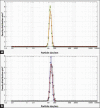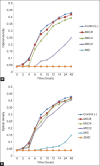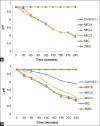Antimicrobial activity of phytofabricated silver nanoparticles using Carica papaya L. against Gram-negative bacteria
- PMID: 37577189
- PMCID: PMC10421558
- DOI: 10.14202/vetworld.2023.1301-1311
Antimicrobial activity of phytofabricated silver nanoparticles using Carica papaya L. against Gram-negative bacteria
Abstract
Background and aim: Antibiotic resistance, especially in Gram-negative bacteria, is a major public health risk affecting all industries requiring the use of antibiotics, including agriculture and animal breeding. This study aimed to use papaya extracts to synthesize silver nanoparticles (AgNPs) and evaluate their antimicrobial activity against various Gram-negative bacteria.
Materials and methods: Silver nanoparticles were synthesized from the aqueous extracts of papaya seed, root, and bark, with AgNO3 used as a reducing agent. The phytofabricated AgNPs were analyzed by ultraviolet-visible absorbance, X-ray diffraction (XRD), Fourier-transform infrared spectroscopy, and photon cross-correlation spectroscopy (PCCS). The disc-diffusion method was used to perform antibacterial analysis, and the minimum inhibitory concentrations (MIC) and minimum bactericidal concentrations were determined. We also investigated the antibiofilm activity of AgNPs and attempted to elucidate the potential mechanism of action on Escherichia coli ATCC 25922.
Results: Phytofabrication of AgNPs was successful with papaya root (PR-AgNPs) and papaya seed (PS-AgNPs), but not with papaya bark. Silver nanoparticles using papaya root and PS-AgNPs were both cubic and showed maximum absorbances of 2.6 and 0.3 AUs at 411.6 and 416.8 nm wavelengths and average hydrodynamic diameters X50 of 59.46 ± 7.03 and 66.57 ± 8.89 nm, respectively. The Ag in both AgNPs was confirmed by X-ray fluorescence by a distinctive peak in the spectrum at the silver Kα line of 22.105 keV. Both AgNPs exhibited broad-spectrum antimicrobial and antibiofilm activity against all Gram-negative bacteria, and PR-AgNPs were slightly better than AgNPs-PS. The MIC ranged from 16 μg/mL-128 μg/mL and 16 μg/mL-64 μg/mL, respectively, for PS-AgNPs and PR-AgNPs. The elucidation of the mechanism of action revealed interference with E. coli ATCC 25922 growth kinetics and inhibition of H+-ATPase proton pumps.
Conclusion: Papaya seed and root extracts were efficient reducing agents for the biogenic synthesis of AgNPs, with noteworthy antibacterial and antibiofilm activities. Future studies should be conducted to identify the phytochemicals and the mechanism involved in AgNPs synthesis.
Keywords: Carica papaya; Gram-negative; antibiotic resistance; biogenic synthesis; silver nanoparticles.
Copyright: © Arsene, et al.
Conflict of interest statement
The authors declare that they have no competing interests.
Figures











References
-
- Arsene M.M.J, Jorelle A.B.J, Sarra S, Viktorovna P.I, Davares A.K.L, Ingrid N.K.C, Carime B.Z. Short review on the potential alternatives to antibiotics in the era of antibiotic resistance. J. Appl. Pharm. Sci. 2022;12(1):29–40.
-
- Arsene M.M.J, Viktorovna P.I, Alla M.V, Mariya M.A, Sergei G.V, Cesar E, Olga P.V. Optimization of ethanolic extraction of Enantia chloranta bark, phytochemical composition, green synthesis of silver nanoparticles, and antimicrobial activity. Ferment. 2022;8(10):530.
-
- Ahmed A, Usman M, Ji Z, Rafiq M, Yu B, Shen Y, Cong H. Nature-inspired biogenic synthesis of silver nanoparticles for antibacterial applications. Mater. Today Chem. 2023;27:101339.
-
- Arsene M.M.J, Viktorovna P.I, Davares A.K.L, Esther N, Nikolaevich S.A. Urinary tract infections:Virulence factors, resistance to antibiotics, and management of uropathogenic bacteria with medicinal plants-a review. J. Appl. Pharm. Sci. 2021;11(7):1–12.
LinkOut - more resources
Full Text Sources
Molecular Biology Databases
Research Materials
